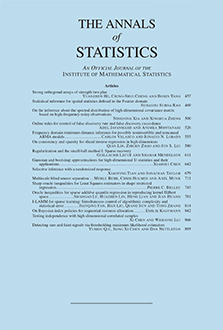Abstract
The use of principal component methods to analyze functional data is appropriate in a wide range of different settings. In studies of “functional data analysis,” it has often been assumed that a sample of random functions is observed precisely, in the continuum and without noise. While this has been the traditional setting for functional data analysis, in the context of longitudinal data analysis a random function typically represents a patient, or subject, who is observed at only a small number of randomly distributed points, with nonnegligible measurement error. Nevertheless, essentially the same methods can be used in both these cases, as well as in the vast number of settings that lie between them. How is performance affected by the sampling plan? In this paper we answer that question. We show that if there is a sample of n functions, or subjects, then estimation of eigenvalues is a semiparametric problem, with root-n consistent estimators, even if only a few observations are made of each function, and if each observation is encumbered by noise. However, estimation of eigenfunctions becomes a nonparametric problem when observations are sparse. The optimal convergence rates in this case are those which pertain to more familiar function-estimation settings. We also describe the effects of sampling at regularly spaced points, as opposed to random points. In particular, it is shown that there are often advantages in sampling randomly. However, even in the case of noisy data there is a threshold sampling rate (depending on the number of functions treated) above which the rate of sampling (either randomly or regularly) has negligible impact on estimator performance, no matter whether eigenfunctions or eigenvectors are being estimated.
Citation
Peter Hall. Hans-Georg Müller. Jane-Ling Wang. "Properties of principal component methods for functional and longitudinal data analysis." Ann. Statist. 34 (3) 1493 - 1517, June 2006. https://doi.org/10.1214/009053606000000272
Information





